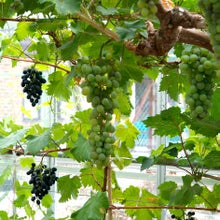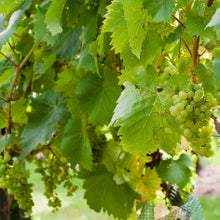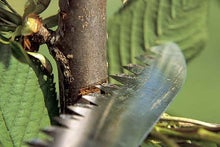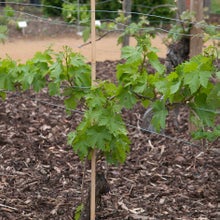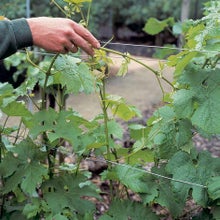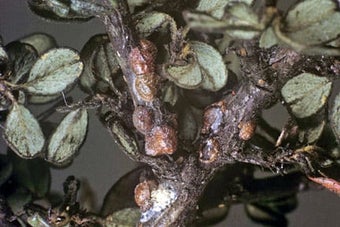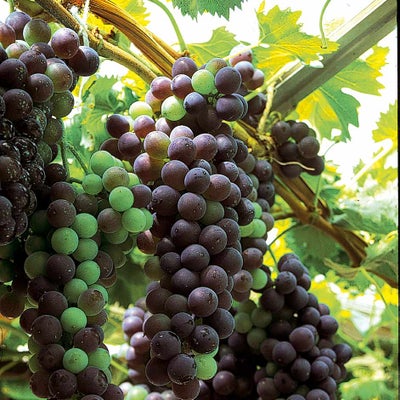
Quick facts
Also known as cordon training
Best method for training vines in a greenhouse
Also suitable for training outdoor grapes on walls, arches and pergolas
Great for growing several different cultivars in a limited space
Vines have a permanent stem or stems, trained onto a support
What is rod and spur (cordon) training
With this method, grapevines are trained to form a permanent stem or stems (rods), from which the fruit-carrying shoots grow. Fruited shoots are pruned back annually in winter to one or two buds, to form fruiting spurs (short shoot stubs). This method is also known as cordon training (the term ‘cordon’ simply refers to a single stem with fruiting spurs).
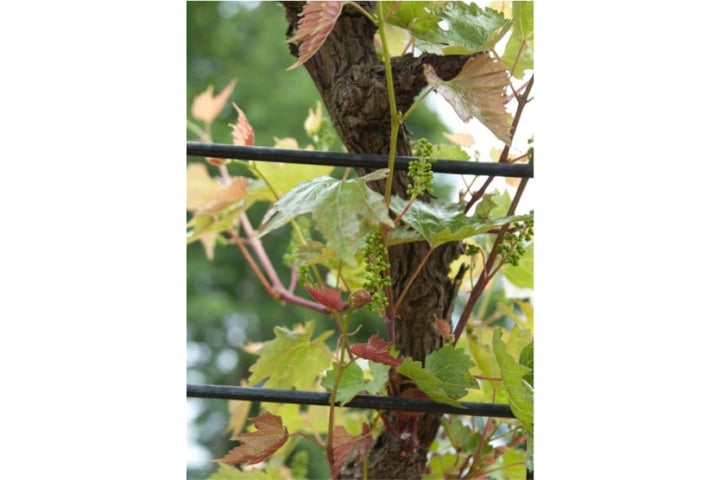
This is a very versatile method of training, suitable for grapevines in gardens and greenhouses. The vines can be trained to have a single permanent stem or a framework of multiple vertical or horizontal stems, to suit their particular location.
Just remember that grapevines are vigorous climbers and just one plant may be sufficient to cover a pergola or the available space inside a greenhouse. Regular pruning is vital to keep their vigour under control and encourage fruiting rather than excessive leafy growth.
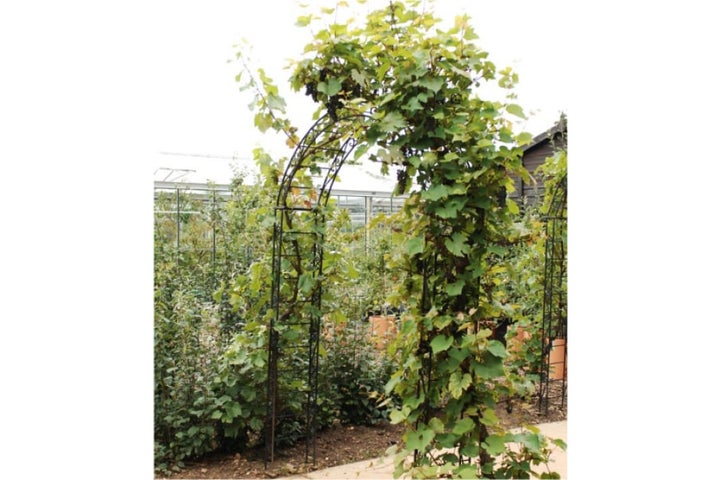
Whether you opt for a single stem or multiple stems, the pruning and training principles are very similar.
You’ll be able to harvest one or two bunches of grapes in the second or third summer after planting, then get increasing numbers in subsequent years.
Single cordon
Training a grapevine as a single vertical cordon restricts its growth, so it takes up less space. This means you could even grow several different cultivars in a greenhouse or outdoors in a relatively small area. Individual vines should be planted 1–1.5m (3–5ft) apart. Single cordons are also ideally suited to training over an archway.
Additionally, this method is useful when growing grapes on a steep slope, where the Guyot training method may not be practical.
Multiple cordon
There are numerous ways to train multiple cordons. But they are all based on having several permanent mature stems (rods) that produce fruiting spurs, from which the fruit-carrying new shoots grow. The permanent rods can be trained vertically or horizontally, or a combination of both.
Train the stems (rods) of multiple vertical cordons 1–1.2m (3–4ft) apart, and train the fruit-carrying side-shoots horizontally. If training the permanent stems horizontally, space them 45–60cm (18–24in) apart, and train the fruit-carrying side-shoots vertically.
When to prune and train cordons
- Early winter (late Nov/Dec) is the main pruning time, when the vine is fully dormant. Pruning later than this can cause the cuts to bleed sap, which can weaken the plant. Sap starts to flow earlier in greenhouse grapevines, so it’s particularly important to complete their pruning in early winter. In sites prone to spring frosts, you could consider delaying pruning until early spring – see FAQs, below
- Spring and summer – train and trim back new shoots and thin out fruit
Supporting and planting
Put supports in place before you plant your grapevine(s).
A sturdy post 1.6–1.8m (5–6ft) tall is a good way to support a single cordon outdoors. If you’ll be growing more than one, space the posts 1.2–1.5m (4–5ft) apart.
If you’ll be training the cordon against a wall or fence or inside a greenhouse, attach strong (2–3mm diameter) galvanised wires horizontally along the wall/fence or between the glazing bars of the glasshouse. The first wire should be 40–45cm (16–18in) from the ground, with subsequent wires at 25–30cm (10–12in) intervals.
Make sure there is a gap between the wires and the wall or glazing behind, to encourage air circulation – thread the wires through ‘vine eyes’ fixed to the wood or masonry, or use special greenhouse vine supports that can be attached to aluminium greenhouse glazing bars.
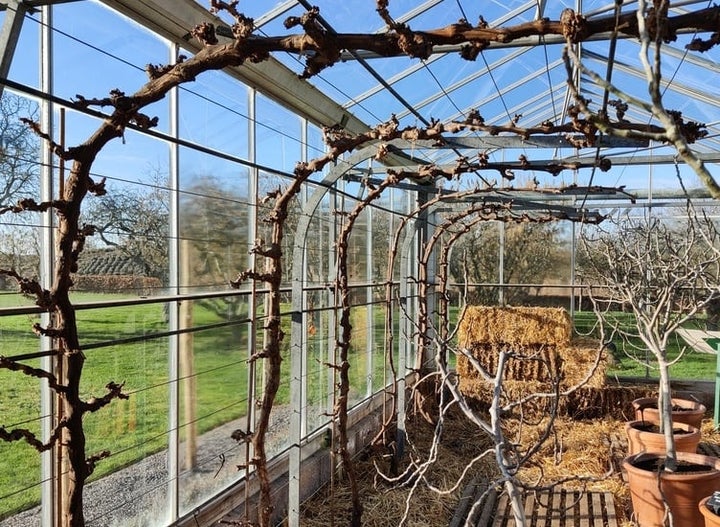
If you’ll be growing cordon vines (single or multiple) in open ground, construct a sturdy post-and-wire support. The posts should stand 1.6–1.8m (5–6ft) tall, and be spaced 4–4.5m (13–15ft) apart. Stretch strong (2–3mm diameter) galvanised wire between the posts, attached using screw-in vine eyes. The first wire should be 40–45cm (16–18in) from the ground and subsequent wires 25–30cm (10–12in) apart.
On a pergola, intall a system of horizontal wires at the top, spaced 25–30cm (10–12in) apart.
When and how to plant
Plant new grapevines during the dormant season (late autumn until early spring). Planting in early spring is generally preferable, to avoid winter damage.
- When planting a bare-root vine, position it so the first roots are just below the soil surface – look for the soil mark at the base of the stem as a guide. If the plant is grafted, make sure the graft point on the stem is kept well above the soil surface
- When planting a container-grown vine, position it at the same soil level it was growing in the pot
- When planting against a wall or in a greenhouse, leave at least 20cm (8in) between the vine and the wall or glazing
For more on planting and growing grapevines, see our guides:
Single cordon – initial pruning and training
Year 1 – winter
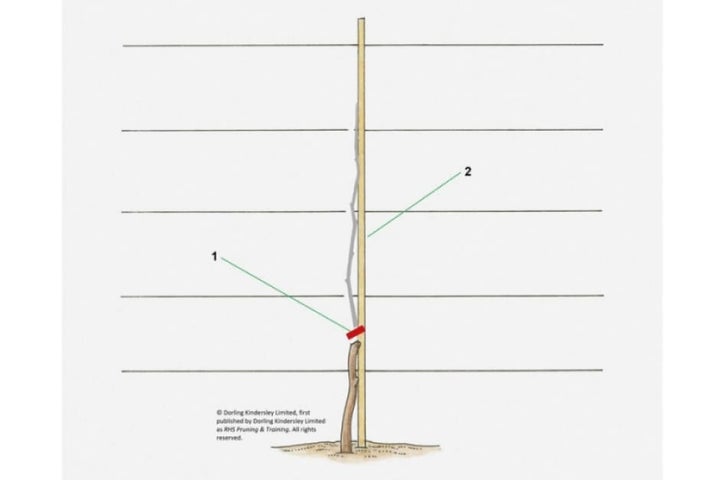
- After planting at the base of a sturdy support system, prune the main (leading) stem back, cutting above a healthy bud near the first wire
- Insert a long bamboo cane next to the vine and tie it to the wire supports
Year 1 – summer
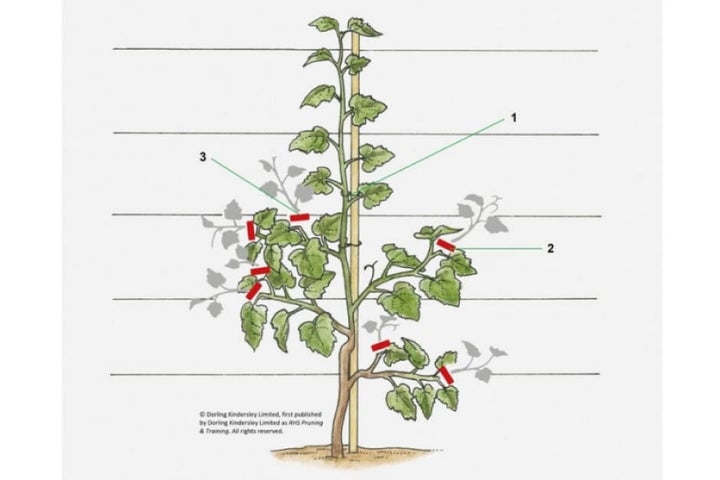
- Tie in the replacement main shoot vertically to the bamboo cane
- Several shoots may start growing from the spurs (stubs of last year’s shoots) on the vertical stem. Select one shoot per spur and remove the rest. Cut back the selected shoots to five or six leaves and tie them to the horizontal wires
- Trim back any other growth to one leaf
Year 2 – winter
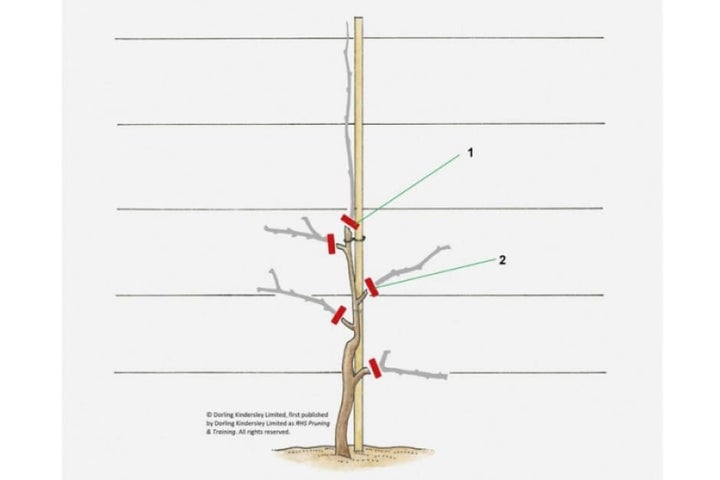
- Cut back last year’s growth of the main vertical stem by two-thirds, pruning above a bud
- Prune back the side-shoots to one strong plump bud (or two buds if the first one doesn’t look strong), to start developing fruiting spurs
Year 2 – summer
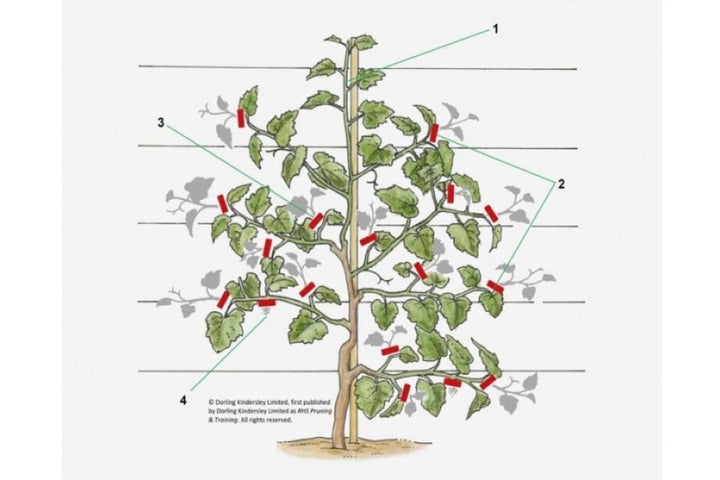
- Tie in the replacement main shoot vertically to the bamboo cane
- Select one shoot per spur (stub of last year’s shoot) and remove the surplus shoots. Prune back the selected shoots to five or six leaves and tie them to the horizontal wires
- Trim back any side-shoots to one leaf, as well as any re-growth from the previously pruned shoots
- Either remove any developing fruit, so the vine can concentrate on establishment, or leave just one or two bunches to ripen
Year 3 – winter
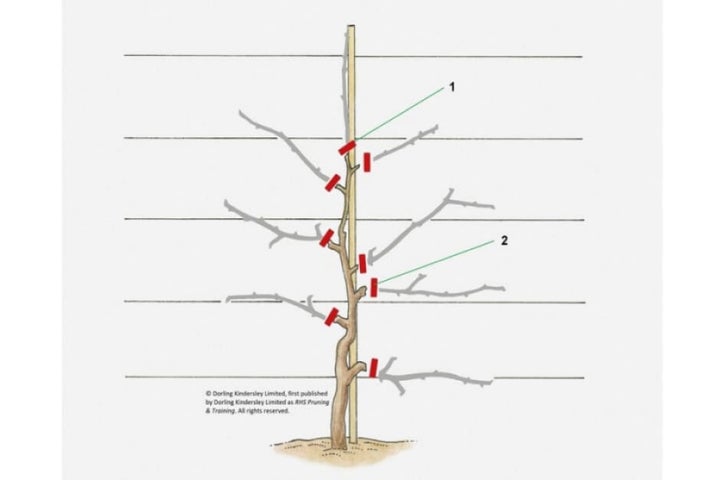
- Cut back last year’s growth on the main vertical stem by half to two-thirds, pruning above a bud
- Prune back all the side-shoots to one strong bud (or two buds if the first one doesn’t look strong), to continue developing the spur system
From here onwards, use the pruning method for an established cordon, below.
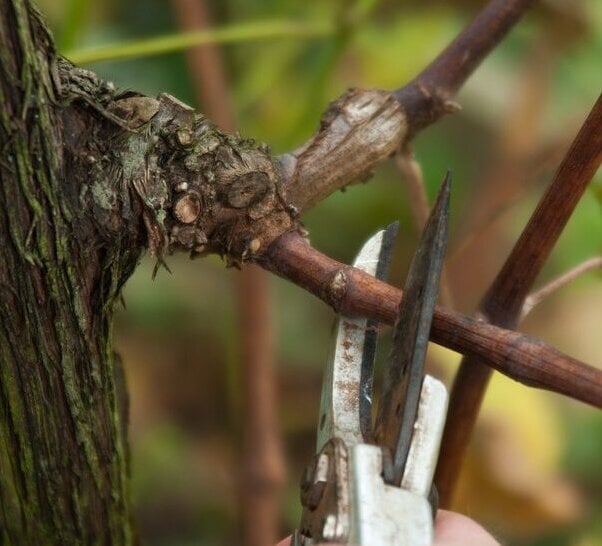
Single cordon – pruning established vines
Year 3 onwards – spring and summer
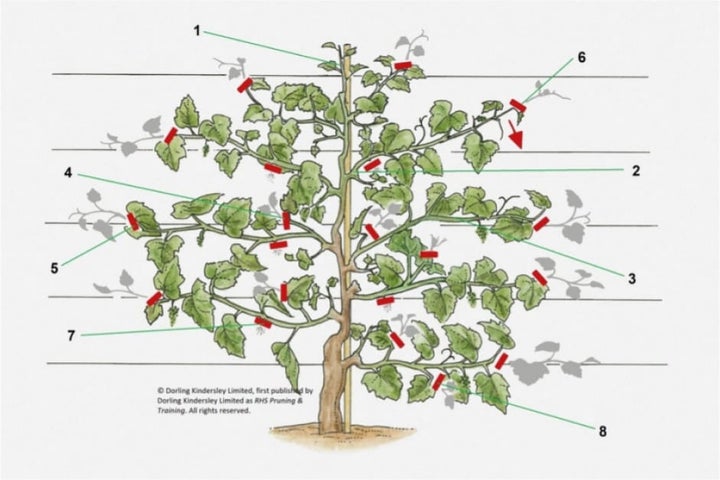
- Continue tying in the main stem vertically until it reaches the desired height
- In spring, allow only a couple of side-shoots to develop from each spur (one spare). Remove any surplus shoots
- Select the stronger side-shoot carrying flowers and tie it to the support. If growing in a greenhouse, do it early in the morning to the reduce the risk of the shoots breaking off. The selected shoots should be spaced every 25–30cm (10–12in)
- Remove each of the spare shoots, pruning them back to one leaf
- Continue tying the selected side-shoots to the horizontal wires as they grow and prune them to two leaves past the developing flower cluster
- Shorten non-flowering side-branches to five leaves
- Let only one flower cluster develop per side-shoot for dessert grapes. With wine grapes, you can allow more flower clusters to form
- During the growing season, regularly cut back any shoots growing from the side-shoots to one leaf, and any further growth from the previously pruned side-shoots to one leaf past the previous cut
Indoor grapes will also benefit from fruit thinning – see our guide:
Year 3 onwards – early winter
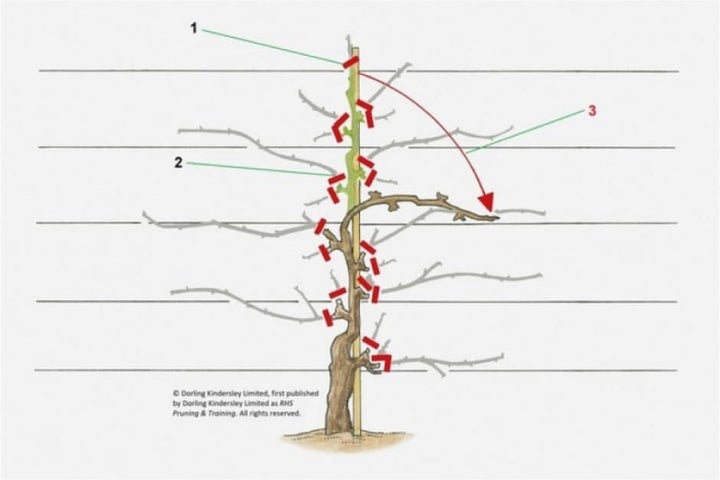
- Cut back the main vertical stem to a bud just below the top wire or top of the support
- Prune back all the side-shoots to one strong plump bud (or two buds if the first one doesn’t look strong). If the spur systems (short branch stubs) become over-crowded, remove the older parts with a pruning saw, but make sure you keep some spurs with plump buds
- For greenhouse grapevines – late winter If practical, consider untying the top half to two thirds of the main stem and lower it down in early to mid-February when the sap starts rising. This will reduce the apical dominance of the top part of the main stem and encourage the buds to break evenly all along it, including the lower parts. Allow the top half to two-thirds to bend down, making sure the stem is supported to prevent damage – tie it to the horizontal wires or suspend it from the greenhouse roof. As soon as the buds on the spurs (the knobbly bits where the main side-shoots were cut back to a single bud) start showing signs of growth, tie the main stem back into its vertical position
Multiple cordon – vertical training
If you want to cover a large sunny wall or grow just one vine in a greenhouse, consider training it as a multiple cordon. Install the horizontal wire supports first, as described previously.
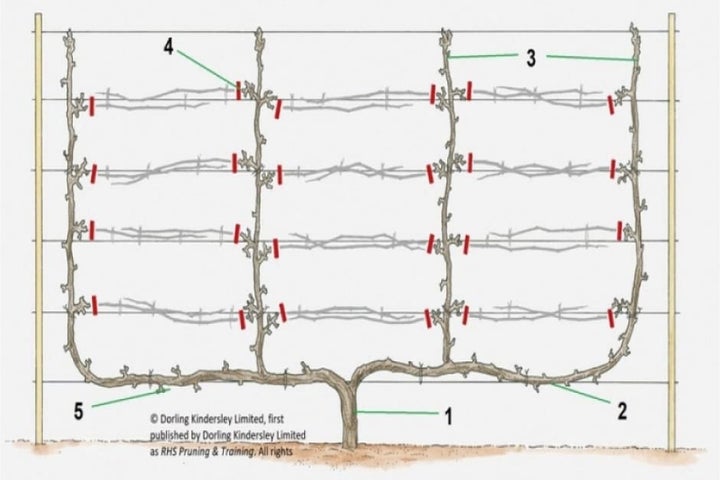
- Allow the newly planted vine to grow two strong vertical shoots from near its base, 40–45cm (16–18in) from the ground. Remove any weak or excess shoots
- At the end of the summer, lower the two selected shoots in opposite directions and tie along the lowest horizontal wire
- In spring, side-shoots will start growing from the horizontal arms. Select well-placed shoots to form the multiple permanent vertical stems (rods). They should be spaced 1–1.2m (3–4ft) apart. Prune the surplus shoots growing from the horizontal stem to one leaf
- Prune all the permanent vertical stems as for a vertical cordon (see above)
- Remove the excess shoots developing from the horizontal part
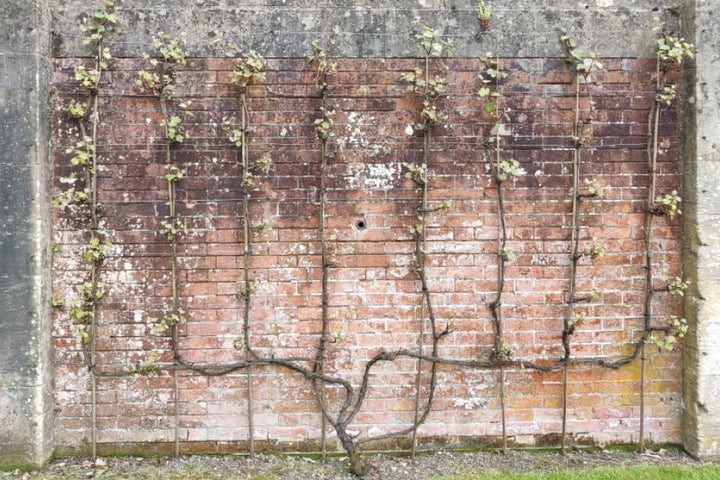
Problem solving
Frequently asked questions
Why did my grapevine bleed after pruning?
If pruned late, in January or beyond, when the sap is starting to rise, grapevines are prone to bleeding sap from pruning cuts. This particularly affects plants growing in a greenhouse or if you make large pruning cuts into older wood. There is nothing you can do to halt the bleeding – it will stop naturally when the vine starts growing. In future years, finish pruning by mid-winter.
My grapevine’s new shoots often get damaged by frosts – should I delay pruning?
Yes, in sites prone to frost in spring, delay pruning until March or early April, so the buds burst later and new shoots are less likely to be hit by frost. The resulting bleeding won’t usually have a significant effect on a healthy vine. However, if you want to make any larger cuts into older wood, do it when the vine is fully dormant, by the middle of winter.
More about grape pruning
The following RHS books are widely available to buy, or can be borrowed by RHS Members from the RHS Lindley Library:
- Grapes: indoors and out by Harry Baker and Ray Waite
- RHS Pruning & Training by Christopher Brickell & David Joyce
Also see our pruning guides:


